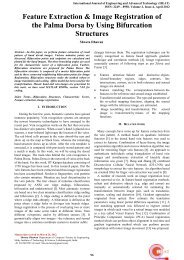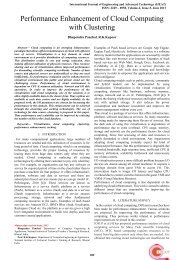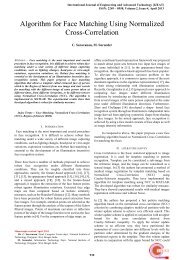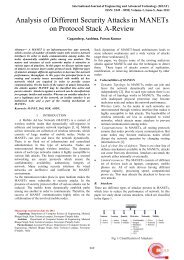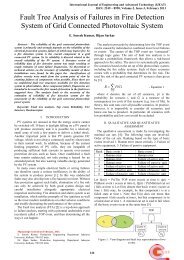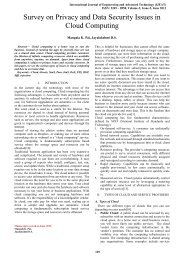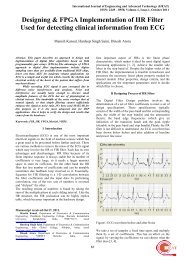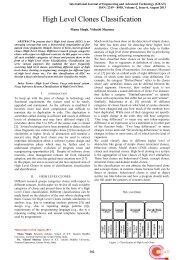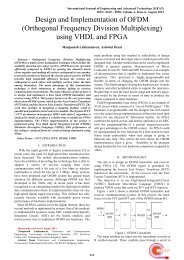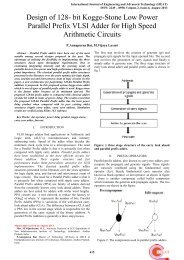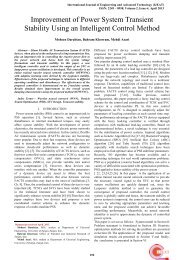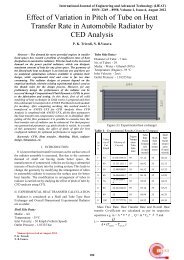Feasibility of Biomass Energy Conversion Technologies For The ...
Feasibility of Biomass Energy Conversion Technologies For The ...
Feasibility of Biomass Energy Conversion Technologies For The ...
Create successful ePaper yourself
Turn your PDF publications into a flip-book with our unique Google optimized e-Paper software.
International Journal <strong>of</strong> Engineering and Advanced Technology (IJEAT)<br />
ISSN: 2249 – 8958, Volume-2, Issue-4, April 2013<br />
<strong>Feasibility</strong> <strong>of</strong> <strong>Biomass</strong> <strong>Energy</strong> <strong>Conversion</strong><br />
<strong>Technologies</strong> <strong>For</strong> <strong>The</strong> Wattle Company’s Vumba<br />
Sawmill Wood Waste<br />
Abstract-A broad range <strong>of</strong> conversion technologies is currently<br />
available for generating a diverse array <strong>of</strong> energy products from<br />
sawmill wood waste. <strong>The</strong> choice <strong>of</strong> conversion technology will<br />
depend on cost <strong>of</strong> capital, the volume <strong>of</strong> wood waste available,<br />
access to energy markets, the prices for each renewable energy<br />
product and the cost <strong>of</strong> the wood waste. <strong>The</strong> purpose <strong>of</strong> this<br />
research project was to investigate the feasibility <strong>of</strong> the various<br />
options <strong>of</strong> sawmill wood waste conversion technologies at <strong>The</strong><br />
Wattle Company’s Vumba Sawmill so as to value add sustainably<br />
in an environmentally friendly manner. <strong>The</strong> outcome favoured<br />
Briquetting as the most feasible conversion technology for the<br />
wood waste. <strong>The</strong> plant capacity will be 2.25 tonnes having an<br />
annual output <strong>of</strong> 689.04 tonnes with a target market <strong>of</strong> 9-10%<br />
regional. <strong>The</strong> Investment required was US$ 65 472.92 with<br />
Payback Period <strong>of</strong> 1 year 3 months and the Net Present Value was<br />
US$ 325 429.08. <strong>The</strong> project’s location is Manicaland Province in<br />
the Vumba Eastern Highlands <strong>of</strong> Zimbabwe.<br />
Index Terms— Bioenergy, Bi<strong>of</strong>uels, <strong>Biomass</strong>, Renewable<br />
<strong>Energy</strong>, Sawmill wood waste.<br />
I. INTRODUCTION<br />
<strong>The</strong> intention is to come up with a biomass energy conversion<br />
technology that adds value to the Wattle Company’s Vumba<br />
Sawmill biomass residues and exploit this biomass renewable<br />
energy resource in an environmentally friendly manner. <strong>The</strong><br />
Wattle Company is a forestry and Timber manufacturing<br />
Company that produces a lot <strong>of</strong> forestry and sawmilling wood<br />
residues. <strong>The</strong> Wattle Company owns approximately 45 276<br />
hectares <strong>of</strong> land in the eastern districts <strong>of</strong> Zimbabwe <strong>of</strong> which<br />
26 439 hectares have been developed into pine, wattle and<br />
eucalyptus plantations. <strong>The</strong>re is uncertainty in the forestry<br />
and timber industry over the appropriate technology to use<br />
when producing ‘renewable energy’ products and the amount<br />
as well as type <strong>of</strong> wood waste that will be required for each<br />
conversion technology. Sawmill wood wastes are either<br />
non-used or burnt inefficiently in their loose form causing air<br />
pollution. Handling, transportation and storage <strong>of</strong> these<br />
materials are also very difficult due to their low density.<br />
<strong>The</strong> Wattle Company Vumba Sawmill produces huge<br />
quantities <strong>of</strong> biomass wastes but they are used inefficiently<br />
causing extensive pollution to the environment. Due to the<br />
enormous production <strong>of</strong> timber, a lot <strong>of</strong> wood wastes are<br />
produced and disposal <strong>of</strong> these is a problem.<br />
Manuscript received on April,2013.<br />
Kunatsa Tawanda, Fuels & <strong>Energy</strong> Department, Chinhoyi University <strong>of</strong><br />
Technology, Chinhoyi, Zimbabwe.<br />
Musademba Downmore, Fuels & <strong>Energy</strong> Department, Chinhoyi<br />
University <strong>of</strong> Technology, Chinhoyi, Zimbabwe.<br />
Kunatsa T, Musademba D<br />
541<br />
<strong>The</strong> Environmental Management Agency (EMA) and<br />
National Social Security Agency (NSSA) have highlighted<br />
that something must be done as soon as possible to solve this<br />
problem citing risks <strong>of</strong> fire from the heaps <strong>of</strong> sawmill wood<br />
wastes and the consequences could be devastating. <strong>The</strong><br />
Wattle Company is showing an increasing interest in<br />
Renewable <strong>Energy</strong> conversion <strong>Technologies</strong> (RETs) so as to<br />
value add and solve the problems <strong>of</strong> sawmill wood waste<br />
disposal as well as energy and power shortages which are<br />
adversely affecting on production.<br />
<strong>The</strong> Wattle Company Limited is into forest and timber<br />
products business with five core businesses, namely the<br />
production <strong>of</strong>:<br />
Pine Sawn timber<br />
Eucalyptus sawn timber<br />
Wattle Extract<br />
Eucalyptus poles, and<br />
Charcoal<br />
AIM<br />
To come up with a biomass energy conversion technology<br />
that adds value to the Wattle company’s Vumba Sawmill<br />
biomass residues and exploit this biomass renewable energy<br />
resource in an environmentally friendly manner.<br />
II. OBJECTIVES<br />
To assess the Vumba Sawmill wood waste resource base<br />
To quantify all the sawmill wood waste produced per<br />
year at the Wattle Company’s Vumba sawmill<br />
To assess the properties <strong>of</strong> the sawmill wood waste<br />
To determine the energy production potential <strong>of</strong> the<br />
sawmill wood waste<br />
To contrast possible biomass conversion technologies<br />
and select the best conversion technology that adds value<br />
To assess the market, risks, technical and economic<br />
viability <strong>of</strong> the project<br />
III. METHODOLOGY<br />
Assessment <strong>of</strong> Resource base-field visits were done and data<br />
was gathered<br />
i. Quantification <strong>of</strong> sawmill biomass residues-sawmill<br />
recovery and production data was compiled and volume<br />
ratios <strong>of</strong> input logs, timber produced and sawmill waste<br />
generated were computed over several months and the<br />
average volume and/or mass <strong>of</strong> sawmill biomass<br />
residues was found<br />
ii. Assessment <strong>of</strong> properties <strong>of</strong> the Vumba sawmill wood<br />
waste-experiments were carried out to ascertain the<br />
properties (moisture content and ash content) <strong>of</strong> a
<strong>Feasibility</strong> <strong>of</strong> <strong>Biomass</strong> <strong>Energy</strong> <strong>Conversion</strong> <strong>Technologies</strong> <strong>For</strong> <strong>The</strong> Wattle Company’s Vumba Sawmill Wood Waste<br />
mixture <strong>of</strong> the sawmill residues (<strong>of</strong>f cuts, wood chips,<br />
wood shavings, bark)<br />
iii. Determination <strong>of</strong> energy production potential-wood<br />
biomass tables and energy conversion factors were used<br />
in conjunction with experimental results<br />
iv. Technical and economic viability assessment-technical<br />
specifications, technical requirements capital and<br />
maintenance costs were analysed for the conversion<br />
technologies and Payback Period as well as Net Present<br />
Value was calculated.<br />
IV. RESULTS<br />
Results <strong>of</strong> Resource Base Assessment<br />
<strong>The</strong> Wattle Company (WACO) owns the Vumba Eucalyptus<br />
resource <strong>of</strong> 1900Ha consisting <strong>of</strong> E. Grandis and E.<br />
Cloeziana. This represents 8% <strong>of</strong> the total WACO resource.<br />
Vumba Timbers utilize this for Treated and untreated Poles,<br />
Charcoal and Sawlogs. <strong>The</strong> sustainable timber resource is<br />
25000m 3 / annum up to 2014 and 40000m 3 / annum after<br />
2014.<br />
<strong>The</strong>re are three main products from the 1900Ha <strong>of</strong> eucalyptus<br />
plantation, these are:<br />
Poles<br />
A sustainable yield <strong>of</strong> 700m 3 per month is obtained. This is<br />
from the middle part <strong>of</strong> a fully grown tree and from thinings.<br />
Charcoal<br />
A yield <strong>of</strong> 800 tonnes per month is obtained. This is from the<br />
top most part <strong>of</strong> the tree from diameter 13 to 7cm. This<br />
utilizes the small diameter parts <strong>of</strong> the tree, 13cm to 7cm.<br />
This is primarily the waste that cannot be utilized as sawlogs<br />
or poles.<br />
Sawlogs<br />
<strong>The</strong> sustainable yield for the next 5 years is 25000 m 3 per<br />
annum thereafter it is going to be 50000m 3 per annum. This<br />
utilizes the lower part <strong>of</strong> the tree up to 20cm diameter.<br />
Results on assessment <strong>of</strong> sawmill residue conversion<br />
technologies<br />
1. Direct combustion <strong>of</strong> biomass to generate super-heated<br />
steam by heat transfer<br />
Direct combustion is the process used by over 90% <strong>of</strong> the<br />
world’s bioenergy plants. In general, the hot gases derived<br />
from biomass combustion flow over a set <strong>of</strong> tube banks, heat<br />
the water in the tube banks to produce steam. This is similar<br />
to the technology employed by many timber mills that use<br />
their wood waste to produce heat and steam for drying or to<br />
operate fiberboard presses. Direct combustion <strong>of</strong> biomass to<br />
generate electricity and heat is termed cogeneration <strong>of</strong><br />
Combined Heat and Power (CHP). By adding a steam turbine<br />
to the direct combustion processes it is possible to generate<br />
electricity which can be used on site or sold into the grid.<br />
2. Co-firing - Combustion <strong>of</strong> wood waste with coal and/or<br />
bagasse (from sugar refineries) to generate electricity. Wood<br />
waste can be supplied in multiple forms, including wood<br />
chips, wood gas (from gasification) or bio-oil (from<br />
pyrolysis).<br />
3. Pyrolysis - <strong>The</strong> heating <strong>of</strong> wood waste in a controlled<br />
environment (with no oxygen) to produce varying quantities<br />
<strong>of</strong> oil, gas and charcoal. <strong>The</strong> gas can be burnt to produce<br />
electricity and the bio-oil can be used as a chemical feedstock<br />
or as a substitute for diesel fuel by stationary power<br />
542<br />
generators, which can be transferred between sites by<br />
tankers.<br />
4. Gasification - <strong>The</strong> heating <strong>of</strong> wood with a small amount <strong>of</strong><br />
oxygen under conditions that turn a high proportion <strong>of</strong> the<br />
wood into a gas. It is a highly efficient process and some<br />
early commercial applications <strong>of</strong> the technology are<br />
available. <strong>The</strong>re are still some technical difficulties<br />
associated with the combined cycle gas power plants to be<br />
overcome. However, it is possible to use the wood gas for<br />
co-firing operations in coal furnaces.<br />
5. Pelletisation/briquetting - Engineered fuels such as pellets<br />
and briquettes are made by compressing fine wood particles<br />
and resinous compounds in the presence <strong>of</strong> heat to produce<br />
small blocks that can be co-fired in coal-fired power stations<br />
or used directly in home heating units. Large quantities <strong>of</strong><br />
wood pellets and briquettes can be as a commercial and home<br />
heating resource.<br />
6. Chemical-biological production <strong>of</strong> liquid fuels – <strong>The</strong><br />
production <strong>of</strong> liquid fuels such as ethanol from wood waste is<br />
based on a series <strong>of</strong> chemical reactions and biological<br />
processes which convert wood into chemically-simple sugars<br />
and then ethanol.<br />
Quantity <strong>of</strong> Vumba Sawmill wood waste<br />
Table 1 represents data on Vumba sawmill wood waste as<br />
derived from the input logs. Vumba Sawmill operates for 22<br />
days a month thus no operations are undertaken during the<br />
weekends. Table 1 summarizes the production data as from<br />
February to July 2009.<br />
= 63.81 tonnes/month<br />
Average sawmill wastes = 2900.61 kg/day<br />
Table: 1 Quantity <strong>of</strong> Vumba Sawmill biomass residues<br />
Oven drying experimental results on moisture content<br />
3 samples <strong>of</strong> sawmill waste were oven dried for several hours<br />
to a constant mass (all the water evaporated), the results are<br />
summarized in table 2 below:<br />
Table 2: Moisture content experimental results<br />
INITIAL<br />
WEIGHT<br />
Sample1<br />
(g)<br />
828<br />
Sample<br />
2 (g)<br />
1236<br />
Sample<br />
3 (g)<br />
1089<br />
TEST TIME<br />
1 1300 hrs 632.0 777.0 749.5
2 1900 hrs 583.5 718.0 738.5<br />
3 2300 hrs 563.5 690.0 734.0<br />
4 0100 hrs 549.5 685.5 732.0<br />
5 0300 hrs 548.5 680.0 731.0<br />
6 0500 hrs 548.0 680.0 728.5<br />
7 1100 hrs 548.5 680.0 728.0<br />
8 1400 hrs 547.5 679.0 724.5<br />
Moisture content on wet basis (MCwb)<br />
MCwb = W x 100<br />
W D<br />
Where : MCwb is the moisture content on wet basis<br />
: W is the weight <strong>of</strong> water<br />
: D is the weight <strong>of</strong> dry material<br />
SAMPLE 1<br />
MCwb =<br />
828<br />
279<br />
SAMPLE 2<br />
MCwb =<br />
SAMPLE 3<br />
MCwb =<br />
548.<br />
5<br />
548.<br />
5<br />
x 100 = 34%<br />
1236 680 x 100 = 45%<br />
556 680<br />
1089 728 x 100 = 33%<br />
361 728<br />
Average moisture content = 34 45<br />
3<br />
33 = 37.3%<br />
Moisture content for Vumba sawmill residues = 37.3%<br />
This moisture content shall be used to calculate the energy<br />
production potential <strong>of</strong> the biomass residues.<br />
Experimental results on determination <strong>of</strong> ash content<br />
2 samples <strong>of</strong> oven dried sawmill biomass mixture (chips,<br />
bark, sawdust and shavings) were measured, burnt<br />
completely the oven dried sample to ash and the mass <strong>of</strong> ash<br />
was measured. Table 3 shows the ash content experimental<br />
results<br />
Table 3: Ash content experimental results<br />
Sample 1 Sample 2<br />
Mass <strong>of</strong> empty crucible (g) 42.43 41.72<br />
Mass <strong>of</strong> sample (0% water) (g) 10.00 13.60<br />
Gross mass after burning (g) 42.85 42.25<br />
Mass <strong>of</strong> ash only (g) 0.42 0.53<br />
Calculation <strong>of</strong> Ash Content<br />
<strong>For</strong> sample 1:<br />
% <strong>of</strong> ash = 3.06 %<br />
International Journal <strong>of</strong> Engineering and Advanced Technology (IJEAT)<br />
ISSN: 2249 – 8958, Volume-2, Issue-4, April 2013<br />
543<br />
<strong>For</strong> sample 2:<br />
% <strong>of</strong> ash = 2.84 %<br />
average ash content = 3 . 06 2.<br />
84 = 2.95<br />
2<br />
average ash content <strong>of</strong> Vumba Sawmill residue = 2.95 %<br />
This ash content will be used below to calculate the energy<br />
production potential <strong>of</strong> the biomass residues.<br />
Calculation <strong>of</strong> energy production potential<br />
Data:<br />
<strong>The</strong> author used average wood biomass values and other<br />
relevant information as follows:<br />
<strong>The</strong> moisture content (MCw) <strong>of</strong> wood waste is<br />
37.3%<br />
<strong>The</strong> ash content (ACw) <strong>of</strong> wood waste is 2.95%<br />
<strong>The</strong> dry ash free matter is 59.75%<br />
<strong>The</strong> Hydrogen content is 5.5%<br />
HHVdaf = 20400kJ/kg<br />
<strong>For</strong> 1kg <strong>of</strong> wood the composition is as follows:<br />
Mass <strong>of</strong> water in wood = 0.5kg<br />
Mass <strong>of</strong> ash in wood = 0.01kg<br />
Mass <strong>of</strong> dry ash free material = 0.49kg<br />
(i) Moisture content on dry ash free basis, (MCdaf)<br />
M w<br />
=<br />
M<br />
=<br />
M<br />
M w<br />
M M<br />
=<br />
1<br />
daf<br />
0 . 37<br />
0.<br />
37<br />
= 0.62<br />
0.<br />
03<br />
(ii) Ash content on dry basis (ACd) =<br />
tot<br />
=<br />
=<br />
w<br />
M<br />
daf<br />
ash<br />
M<br />
M<br />
M<br />
tot<br />
ash<br />
ash<br />
M<br />
M<br />
0 . 03<br />
1 0.<br />
37<br />
= 0.05<br />
(iii) Lower Heating Value on dry and ash free basis,<br />
(LHVdaf) = HHVdaf – [H]daf x 20300 - MCdaf x2260kJ/kg<br />
= 20400 – 0.055 x 20300 –0.62 x 2260<br />
= 17882.3 kJ/kg<br />
(iv) Lower heating value on wet basis, LHVw=LHVdaf x<br />
= 17882.3 x 0 . 597<br />
1<br />
Lower heating value on wet basis, LHVw=10684.67kJ/kg<br />
(v) Wood waste energy = LHVw x mass<br />
= 10684.67 x 2900.61<br />
= 30992018.56KJ/day<br />
= 30 992 MJ/day<br />
ash<br />
w
<strong>Feasibility</strong> <strong>of</strong> <strong>Biomass</strong> <strong>Energy</strong> <strong>Conversion</strong> <strong>Technologies</strong> <strong>For</strong> <strong>The</strong> Wattle Company’s Vumba Sawmill Wood Waste<br />
Vumba Sawmill <strong>Energy</strong> Production Potential= 30 992<br />
MJ/day<br />
(vi)Power production potential =<br />
energy<br />
time<br />
= 30992018560<br />
24x60x60<br />
= 358796.2963<br />
= 0.3587MW<br />
Vumba Sawmill Power Production Potential = 359 kW<br />
Vumba Sawmill Power Production Potential = 359 kW<br />
This value shows that if all the Vumba Sawmill biomass<br />
residues are utilized to produce electricity, the maximum<br />
power output using any biomass conversion technology<br />
without considering conversion efficiencies will be 359 kW.<br />
Interpretation <strong>of</strong> data and discussion <strong>of</strong> results<br />
A total <strong>of</strong> 8181.88 (30.992 x 22 x 12) GJ per annum energy<br />
production potential shows that quite a considerable amount<br />
<strong>of</strong> energy was being used inefficiently. This energy could be<br />
made use <strong>of</strong> by converting it to some form <strong>of</strong> fuel and/or<br />
energy. A calculation <strong>of</strong> the power production potential<br />
assisted in choosing the alternative conversion technologies<br />
to consider for the Vumba Sawmill biomass waste.<br />
Vumba sawmill power requirement is 316.648 kW. To<br />
produce 30MW using Cogeneration and Direct Combustion,<br />
300 000 tonnes <strong>of</strong> wood waste are needed. <strong>The</strong> quantification<br />
<strong>of</strong> Vumba Sawmill biomass waste yielded 2.9 tonnes <strong>of</strong><br />
residue per day. <strong>The</strong> amount <strong>of</strong> residue required for Vumba<br />
sawmill will be: 316.648 300000<br />
30000 x = 9499.44 tonnes/year,<br />
but the quatification <strong>of</strong> the residues shows 2.9 tonnes/day x<br />
22days x 12 months = 765.6 tonnes/yr. This rules out<br />
Cogeneration Co-firing and Direct Combustion conversion<br />
technologies.<br />
Most Pyrolysis and Gasification plants start from a<br />
generation capacity <strong>of</strong> 500kW upwards. Though the available<br />
raw material is able to meet the sawmill power requirements<br />
the technological requirements are a drawback to these<br />
biomass conversion technologies with regard to Vumba<br />
sawmill wood waste.<br />
<strong>The</strong> computed Power Production Potential <strong>of</strong> 359 kW shows<br />
that the raw material available is adequate to power the<br />
sawmill but the technology resource requirements are a<br />
limitation. This promotes shifting to a conversion technology<br />
that caters for the thermal needs <strong>of</strong> the sawmill and excess<br />
fuel to be sold as a form <strong>of</strong> value addition. <strong>The</strong> study outcome<br />
above leads the author to consider Direct Combustion and<br />
Fuel Briquetting. From the research results, the many<br />
advantages <strong>of</strong> fuel briquetting over Direct Combustion and<br />
other biomass conversion technologies and their<br />
environmentally friendly impacts, it is quite a better option to<br />
briquette the biomass residues and the researcher chooses this<br />
as the most feasible conversion technology with regard to<br />
Vumba Sawmill wood waste.<br />
From the resource base and quantification <strong>of</strong> Vumba<br />
Sawmill waste results as well as from the biomass energy<br />
assessment it can be deduced that there is more than enough<br />
raw material for the briquetting project. <strong>The</strong> summation <strong>of</strong> all<br />
biomass residues gives:<br />
2.9 tonnes/day x 22days x 12 months = 765.6 tonnes/yr. <strong>The</strong><br />
binderless briquetting technology which the author wants to<br />
use has an output <strong>of</strong> 750kg/hr.<br />
544<br />
Given that the conversion efficiency <strong>of</strong> the briquetting<br />
machine is 90%, the required input is as computed below:<br />
output<br />
Input = efficiency<br />
= 750<br />
0.<br />
9<br />
Input = 833.33kg/hr<br />
<strong>The</strong> raw material can supply the machine to be run:<br />
= 3.48 times per day<br />
This implies that the raw material available is adequate to<br />
embark on the proposed binderless briquetting technology<br />
giving 3.48 x 750kg/hr = 2.61ton/day <strong>of</strong> briquettes. Annual<br />
briquette production will be: 2.61ton/day x 22 days x 12<br />
months = 689.04 tonnes.<br />
An important component for briquetting is moisture content.<br />
<strong>The</strong> moisture content experimental result <strong>of</strong> 37.3 % is too<br />
high. <strong>For</strong> briquetting moisture content should be as low as<br />
possible, generally in the range <strong>of</strong> 10 – 15 %. Hence a drier is<br />
needed to reduce the moisture content.<br />
<strong>The</strong> 2.95% ash content experimental result implies that the<br />
raw material is conducive for briquetting. Usually slagging<br />
takes place with biomass fuels containing more than 4% ash<br />
content. <strong>The</strong> ash content is an indicator <strong>of</strong> slagging behaviour<br />
<strong>of</strong> the biomass, the greater the ash content the greater the<br />
slagging behaviour. Vumba Sawmill wood waste ash<br />
constituencies will not have a tendency to devolatalise during<br />
combustion and condense on tubes, especially those <strong>of</strong> super<br />
heaters. Hence the sintering temperature <strong>of</strong> ash will not be<br />
lowered and therefore ash deposition on the boiler’s exposed<br />
surfaces will not take place if the briquettes are used as fuel<br />
for boilers.<br />
Technical and economic viability <strong>of</strong><br />
briquetting/pelletisation<br />
Capacity<br />
Basis: Three machines each 750 kg/hr<br />
Production capacity = 2.25 t/hr (20 hrs/day operation)<br />
Operating days per year 264<br />
Operating hours per year 5280<br />
Capacity utilization 90%<br />
Raw material 765.6 t/yr<br />
Moisture losses 285.6<br />
t/yr<br />
Briquettes produced 689.04<br />
t/yr<br />
Briquettes consumed (Dryer)(7.8% <strong>of</strong> production) 54.04 t/yr<br />
Saleable production 635 t/yr<br />
lnfrastructural facilities<br />
Power 225 kW<br />
Land area 4500m²<br />
Operational shed area 360 m²<br />
Briquetting storage 375 m²<br />
(covered area)<br />
Investments (US$)<br />
Installed cost <strong>of</strong> plant & machinery<br />
(based on US$19170 for each machine) 57510
Land 3317.88<br />
Building 4645<br />
Total investment 65472.92<br />
Cost <strong>of</strong> production (US$)<br />
Power 3009.43<br />
Manpower 1486<br />
Water 176.12<br />
Maintenance (including consumables) 1688.54<br />
Total cost <strong>of</strong> production 6360.09<br />
Total sales (US$96.439/ per tonne x 635tonnes) 61238.765<br />
Less Production cost 6360.09<br />
Less Raw material -<br />
Gross pr<strong>of</strong>it 54878.68<br />
Less expenses US$<br />
Administrative overheads 946.64<br />
Depreciation (Plant 10% Building 5%) 5983.25<br />
Financial cost/interest paid 2014.36 8944.25<br />
Net Pr<strong>of</strong>it 45934.43<br />
Calculation <strong>of</strong> Payback Period<br />
Net cash flows = Net Pr<strong>of</strong>it + depreciation<br />
= 45934.43 + 5983.25<br />
= 51917.68<br />
Pay-back period = 1 year 3 months<br />
Calculation <strong>of</strong> Net Present Value (NPV)<br />
NPV = -I0 +<br />
n<br />
1<br />
B<br />
( 1<br />
C<br />
r)<br />
= -I0 + [PWAF x (B – C)]<br />
where: I0 is the initial investment<br />
B represents the benefits<br />
C represents the costs<br />
PWAF is the Present Worth Annuity Factor<br />
B – C is equivalent to the Net Pr<strong>of</strong>it<br />
PWAF =<br />
PWAF =<br />
1 ( 1<br />
n<br />
r)<br />
1<br />
r<br />
( 1 0.<br />
1)<br />
0.<br />
1<br />
n<br />
20<br />
= 8.51<br />
NPV = -65472.92+ (8.51 x 45934.43)<br />
NPV = 325 429.08<br />
<strong>The</strong> Payback Period <strong>of</strong> 1 year 3 months and a positive Net<br />
Present Value (NPV) <strong>of</strong> US$ 325 429.08 shows that the<br />
project is economically viable/feasible.<br />
Market, Risks and Technical analysis<br />
A larger part <strong>of</strong> the briquettes will be sold to local<br />
Zimbabwean consumers as well as export markets. It can be<br />
deduced from the Literature Review that briquetting is<br />
International Journal <strong>of</strong> Engineering and Advanced Technology (IJEAT)<br />
ISSN: 2249 – 8958, Volume-2, Issue-4, April 2013<br />
545<br />
economically feasible. Water is readily available close to the<br />
project site in the Vumba Eastern Highlands and the<br />
Briquetting plant is to utilise power from the ZESA grid.<br />
<strong>The</strong>re is high risk <strong>of</strong> interruption <strong>of</strong> the production processes<br />
due to power cuts and a standby generator has to be made<br />
available specifically for this project.<br />
<strong>The</strong>re is a risk in that the existing thermal energy market is<br />
dominated by coal, charcoal, firewood and gases. However,<br />
Briquettes are expected to penetrate the market and constitute<br />
a larger market share due to their high calorific value <strong>of</strong><br />
4000Kcal/kg as compared to other competing goods. (P.D.<br />
Grover and S.K.Mishra, FAO 1996). <strong>The</strong> target market is<br />
aimed for in households, commercial and industrial<br />
operations.<br />
V. CONCLUSION<br />
<strong>The</strong> aim <strong>of</strong> the project was to come up with a biomass energy<br />
conversion technology that adds value to the Wattle<br />
Company’s Vumba Sawmill biomass residues and exploit<br />
this biomass renewable energy resource in an<br />
environmentally friendly manner. <strong>The</strong> sustainable quantity<br />
<strong>of</strong> wood waste available is 2.9 tonnes/day. <strong>The</strong>re are quite<br />
proven technologies to utilize this biomass but the amount <strong>of</strong><br />
resource available and the scale <strong>of</strong> required amounts by each<br />
conversion technology are a limitation to most <strong>of</strong> the<br />
conversion technologies. <strong>The</strong> costs <strong>of</strong> briquettes and other<br />
renewable, wood energy derived products are much higher as<br />
compared to the competitive low prices <strong>of</strong> coal, diesel and<br />
charcoal. This study observed that this poor competitiveness<br />
arises mainly from the very high capital cost <strong>of</strong> the plants or<br />
the low price <strong>of</strong> coal and diesel; probably the balance<br />
between the two and this might obscure customer<br />
acceptability <strong>of</strong> the briquettes.<br />
<strong>The</strong> outcome <strong>of</strong> this study favours <strong>Biomass</strong> Briquetting as the<br />
most feasible conversion technology to use for Vumba<br />
Sawmill wood waste. <strong>The</strong> plant capacity will be 2.25 tonnes<br />
having annual output <strong>of</strong> 689.04 tonnes with a target market <strong>of</strong><br />
9-10% regional. <strong>The</strong> Investment required is US$ 65472.92,<br />
the Payback Period shall be 1 year 3 months and the Net<br />
Present Value (NPV) is US$ 325 429.08. <strong>The</strong> project’s<br />
location is Manicaland Province in the Vumba Eastern<br />
Highlands <strong>of</strong> Zimbabwe.<br />
VI. RECOMMENDATIONS<br />
In the light <strong>of</strong> the above conclusion, it is recommended<br />
that <strong>The</strong> Wattle Company’s Vumba Timbers go for the<br />
economically feasible and value adding fuel briquetting<br />
project to meet its thermal needs, solve the problem <strong>of</strong><br />
sawmill residue storage and deposition. <strong>The</strong> selling <strong>of</strong><br />
the surplus briquettes will generate revenue for the<br />
Company.<br />
It is also recommended that an Environmental Impact<br />
Assessment (EIA) be carried out to assess the<br />
developmental impacts <strong>of</strong> the briquetting project. In the<br />
same notion it is recommended that the Company take<br />
detailed feasibility studies for alternative power<br />
generation projects for forestry and sawmilling biomass<br />
residues that will promote demand for and supply <strong>of</strong><br />
energy in an environmentally-friendly manner.<br />
VII. ACKNOWLEDGEMENTS<br />
<strong>The</strong> authors hereby acknowledge Mr J. Musemwa, <strong>The</strong><br />
Wattle Company Projects Director and the entire Wattle
<strong>Feasibility</strong> <strong>of</strong> <strong>Biomass</strong> <strong>Energy</strong> <strong>Conversion</strong> <strong>Technologies</strong> <strong>For</strong> <strong>The</strong> Wattle Company’s Vumba Sawmill Wood Waste<br />
Company personnel for their cooperation and provision <strong>of</strong><br />
research data used in the various stages <strong>of</strong> this research<br />
project.<br />
REFERENCES<br />
1. Bridgwater, A.V. (1999). A Guide to Fast Pyrolysis <strong>of</strong> <strong>Biomass</strong> for<br />
Fuels and Chemicals. Bioenergy Research Group – Aston University,<br />
United Kingdom.<br />
2. Demirbaş, A., A. Şahin-Demirbaş and A. Hilal Demirbaş. 2004.<br />
Briquetting properties <strong>of</strong> biomass waste materials. <strong>Energy</strong> Sources 26:<br />
83-91.<br />
3. Jamie Morton, July 2001, <strong>For</strong>est and Wood Products Research and<br />
Development Corporation (2001) Bioenergy: A future for the<br />
Australian <strong>For</strong>est Industry.<br />
4. Li, Y. and H. Liu. 2000. High pressure densification <strong>of</strong> wood residues<br />
to form an upgraded fuel. <strong>Biomass</strong> and Bioenergy 19: 177-186.<br />
5. National Environmental Policy, Government <strong>of</strong> Zimbabwe-Ministry <strong>of</strong><br />
Environment and Tourism (September 2003)<br />
6. Ndiema, C.K.W., P.N. Manga and C.R. Ruttoh. 2002. Influence <strong>of</strong> die<br />
pressure on relaxation characteristics <strong>of</strong> briquetted biomass. <strong>Energy</strong><br />
<strong>Conversion</strong> and Management 43: 2157-2161.<br />
7. Nupur Sengupta, 2002, Use <strong>of</strong> Wood as a Fuel in Combined Heat and<br />
Power<br />
8. P.D. Grover and S.K.Mishra, FAO 1996<strong>Biomass</strong> Briquetting:<br />
Technology and Practices<br />
9. Stucley C.R, Schuck S.M, Sims R.E.H, Larsen P.L, Turvey N.D and<br />
Marino B.E(2004) <strong>Biomass</strong> energy production in Australia Status costs<br />
and opportunities for major technologies. A report for JVAP in<br />
conjunction with the AGO<br />
10. Sustainable <strong>Energy</strong> Development Authority (1999) Investigation <strong>of</strong><br />
Potential for Electricity Generation from <strong>For</strong>estry By-products in New<br />
South Wales. By Enecon Pty Ltd & CSIRO Australia, June 1999<br />
11. UNEP Collaborating Centre on <strong>Energy</strong> and Environment (January<br />
1997), Implementation strategy to reduce environmental impact on<br />
energy related activities in Zimbabwe<br />
12. Wyman, C.E., B.E. Dale, R.T. Elander, M. Holtzapple, M.R. Ladisch<br />
and Y.Y. Lee. 2005. Comparative sugar recovery data from laboratory<br />
scale application <strong>of</strong> leading pretreatment technologies to corn stover.<br />
Bioresource Technology 96: 2026-2032.<br />
13. Yaman, S., M. Şahan, H. Haykiri-açma, K. Şeşen and S. Küçükbayrak.<br />
2000. Production <strong>of</strong> fuel briquettes from olive refuse and paper mill<br />
waste. Fuel Processing Technology 68: 23-31.<br />
14. Zandersons, J., J. Gravitis, A. Zhurinsh, A. Kokorevics, U. Kallavus<br />
and C.K. Suzuki. 2004. Carbon materials obtained from self-binding<br />
sugar cane bagasse and deciduous wood residues plastics. <strong>Biomass</strong> and<br />
Bioenergy 26: 345-360.<br />
Tawanda Kunatsa<br />
Lecturer, Chinhoyi University <strong>of</strong> Technology,<br />
Department <strong>of</strong> Fuels & <strong>Energy</strong><br />
Educational details:<br />
B.Eng (Hons) Renewable <strong>Energy</strong> (Chinhoyi<br />
University <strong>of</strong> Technology) ; MSc Renewable<br />
<strong>Energy</strong> (University <strong>of</strong> Zimbabwe)<br />
Published papers, workshop presantations &<br />
conference papers<br />
1. <strong>Feasibility</strong> study <strong>of</strong> Biogas production from Water Hyacinth. A case <strong>of</strong><br />
Lake Chivero–Harare, Zimbabwe; Kunatsa T , Madiye L, Chikuku T,<br />
Shonhiwa C, Musademba D - International Journal <strong>of</strong> Engineering<br />
and Technology Volume 3 No. 2, February, 2013 pge 119-128<br />
Downmore Musademba<br />
Lecturer, Chinhoyi University <strong>of</strong> Technology,<br />
Department <strong>of</strong> Fuels & <strong>Energy</strong><br />
Educational details:<br />
BSc Physics (University <strong>of</strong> Zimbabwe); MSc<br />
Renewable <strong>Energy</strong> (University <strong>of</strong> Zimbabwe)<br />
Publications<br />
1. Musademba Downmore, Musiyandaka<br />
Shepherd, Muzinda Andrew, Nhemachena<br />
Barbara and Jambwa Daniel (2011) Municipality<br />
546<br />
Solid Waste (MSW) Management Challenges <strong>of</strong> Chinhoyi Town in<br />
Zimbabwe: Opportunities <strong>of</strong> Waste Reduction and Recycling. Journal<br />
<strong>of</strong> Sustainable Development in Africa, Volume 13, No. 2 (2011)<br />
2. Raphael M. Jingura, Rutendo Matengaifa, Downmore Musademba<br />
and Kumbirai Musiyiwa (2011) Characterisation <strong>of</strong> land types and<br />
agro-ecological conditions for production <strong>of</strong> Jatropha as a feedstock for<br />
bi<strong>of</strong>uels in Zimbabwe. ELSEVIER: Journal <strong>of</strong> <strong>Biomass</strong> and<br />
Bioenergy, Volume 35, (2011):pp2080 -2086<br />
3. Raphael M. Jingura, Downmore Musademba, and Rutendo<br />
Matengaifa (2010) Jatropha curcas L. as a source <strong>of</strong> multiple energy<br />
carriers. International Journal <strong>of</strong> Engineering Science and<br />
Technology, Volume 2, No. 7:pp115-122<br />
4. <strong>Feasibility</strong> study <strong>of</strong> Biogas production from Water Hyacinth. A case <strong>of</strong><br />
Lake Chivero–Harare, Zimbabwe; Kunatsa T , Madiye L, Chikuku T,<br />
Shonhiwa C, Musademba D - International Journal <strong>of</strong> Engineering<br />
and Technology Volume 3 No. 2, February, 2013 pge 119-128



